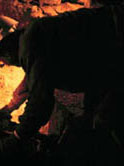
 |
||
 |
||
 |

 |
Crawling through tight, muddy cave passages looking for bones and guano (bat manure) is how some of us, as Museum geologists, do our research. We are looking for bones and guano because these provide us with clues about the animals that lived in an area in the past. Some of the bones are relatively recent (only a few hundred to a few thousand years old). Other bones may be hundreds of thousands to millions of years old.
Caves are excellent places to find bones to study. Once bones are in a cave, they rarely leave (until we excavate them). The conditions in the cave also preserve bones and guano, so they are likely to survive for thousands of years. The bones and guano can tell us what kinds of animals lived in an area, when they lived there, and how the animals, the cave, and the environment have changed over time.
Studying
bones in caves requires special equipment. We wear helmets (to protect
our heads), kneepads (for crawling through small passages), and warm clothing
(caves are cool). We each have a bright light on our helmet (caves have
no light). We also carry extra lights (in case the light on our helmet
goes out). We also use notebooks (to record information about bones we
find), cameras, tape measures, trowels
(to excavate bones for study in the lab), and special carrying containers
(to safely remove fragile bones from the cave).
|
|
Copyright © 2000 Illinois State Museum